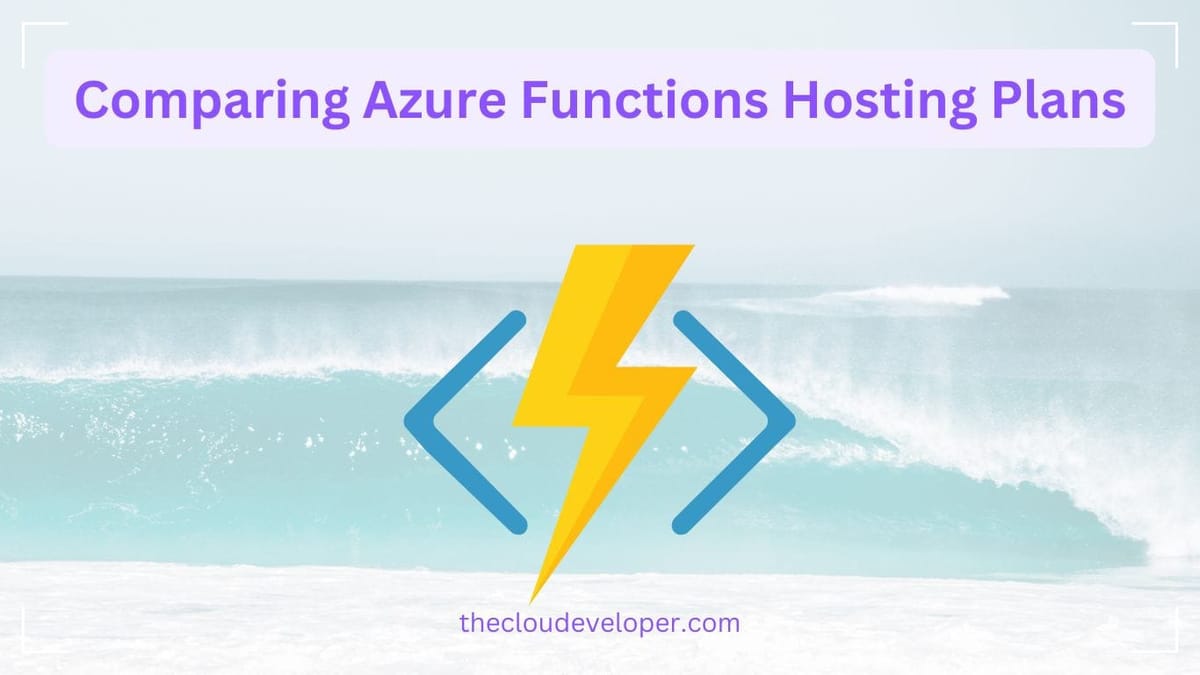Comparing Azure Functions Hosting Plans
Looking for the right Azure Functions hosting plan? This post break down the key options: Consumption, Premium, Dedicated, Container Apps, and the newest Flex Consumption Plan. Whether you're just starting out or scaling up, there's a plan for your project. Good read!

The other day I sit down to renew my AZ-204, and one of the questions called my attention. I don't remember the exact question, but it was related to Azure Functions hosting plans. One of the options was "Flex Consumption Plan" ... Well, I had no idea what was that, and I knew the answer was another, but that got my attention. 🤔
Since I took 5 min to read a bit about them, here is a quick break down of these options. Go grab a drink, and let’s get into it!
Azure Functions?
Before we jump into the hosting plans, let’s quickly recap whats up with Azure Functions:
- Serverless Architecture: You focus on writing code without worrying about the underlying infrastructure.
- Scalability: Automatically scales based on demand—no manual server management!
- Cost-Effective: Pay only for "what you use", which is perfect for startups and small projects.
The Hosting Plans Breakdown
Azure Functions offers five hosting plans now: Consumption Plan, Premium Plan, Dedicated (App Service) Plan, Container Apps , and the new Flex Consumption Plan.
1. Consumption Plan
Best For: Small projects, prototypes, or applications with variable workloads.
- Pricing: You pay per execution, which means if your function isn’t running, you’re not paying.
- Scaling: Automatically scales out to handle incoming requests.
- Limitations:
- Maximum execution time of 5 minutes (can be extended to 10 min through configuring).
- Cold starts can be a bummer if your function hasn’t been triggered in a while - I never really had that other than 3 to 5 sec.
2. Premium Plan
Best For: Applications needing more power and features, like VNET integration.
- Pricing: Fixed monthly fee plus execution costs.
- Scaling: Can scale to zero, but also allows for pre-warmed instances to reduce cold start times.
- Features:
- Supports longer execution times (up to 60 minutes - now why would you?).
- VNET integration for secure connections.
- More powerful infrastructure options.
3. Dedicated (App Service) Plan
Best For: Enterprise applications or those requiring full control over the environment. A long time ago, the company I worked for would only use these. Quite a bunch of money, but predictable.
- Pricing: Fixed monthly fee based on the App Service plan tier.
- Scaling: Manual scaling; you control the number of instances.
- Features:
- Full control over the hosting environment.
- No cold starts since your functions are always warm.
- Ideal for applications with consistent workloads. We were mostly using those for our durable functions.
4. Container Apps Plan
Best For: deploy of containerized function apps in a fully managed environment.
- Pricing: Pay-as-you-go based on resource usage.
- Scaling: Automatically scales based on demand, running alongside other microservices and APIs.
- Features:
- Package custom libraries with your function code and app.
- Migrate code execution from on-premises or legacy apps to cloud-native microservices in containers.
- Avoid the overhead of managing Kubernetes clusters and dedicated compute.
- Access high-end processing power with dedicated CPU compute resources for your functions.
5. Flex Consumption Plan
The new-comer (at least for me).
Best For: high scalability with more control over compute choices.
- Pricing: Pay-as-you-go billing model, with options for always-ready instances.
- Scaling: Instances are dynamically added and removed based on incoming events and configured concurrency.
- Features:
- Always-Ready Instances: You can specify a number of instances that are always ready to handle requests, reducing cold start times.
- Virtual Network Integration: Connect your apps to other Azure services securely.
- Memory Size Selection: Choose between 2 and 4 GB instance memory sizes based on your app's needs.
- Fast Scaling: Scales automatically based on demand, making it perfect for both HTTP and non-HTTP applications.
Key Takeaways
- Consumption Plan is great for lightweight, sporadic workloads.
- Premium Plan strikes a balance between cost and performance, perfect for growing applications.
- Dedicated Plan is for those who need full control and reliability.
- Container Apps plan is perfect for containerized functions without the hassle of K8s.
- Flex Consumption Plan offers a great alternative to both Consumption and Premium: serverless benefits with added flexibility and scalability.
What’s New?
I don't know how recent are this updates, but I find it nice to have yet another option for the Functions: Flex Consumption Plan. Like I mentioned, this is also relevant for those of you prepping for the AZ-204 exam. 😉!
Here's a copy of the comparison from Microsoft Docs:
| Feature | Consumption | Flex Consumption |
|---|---|---|
| Scale to zero | ✅ Yes | ✅ Yes |
| Scale behavior | Event driven | Event driven (fast) |
| Virtual networks | ❌ Not supported | ✅ Supported |
| Dedicated compute (mitigate cold starts) | ❌ None | ✅ Always ready instances (optional) |
| Billing | Execution-time only | Execution-time + always-ready instances |
| Scale-out instances (max) | 200 | 1000 |
Conclusion
I myself used only 3 of those plans so far. Have you tried the Flexible or Container already? Share your experiences in the comments below! I'd also appreciate if you'd let me know if I should try and learn something else to write here as well 😃
Surely choosing the right Azure Functions hosting plan can make a significant difference in your project’s performance - and cost.
And if you’re gearing up for the AZ-204 exam, don’t forget to check out the official resources to stay updated on the latest changes.
Here's the docs: https://learn.microsoft.com/en-us/azure/azure-functions/functions-scale
Thanks for reading and happy clouding! 🚀

